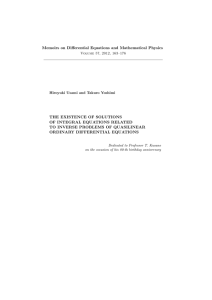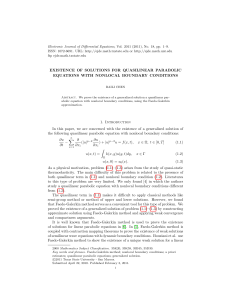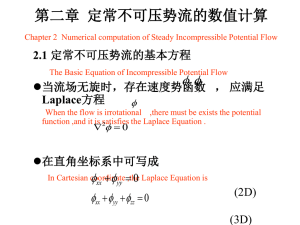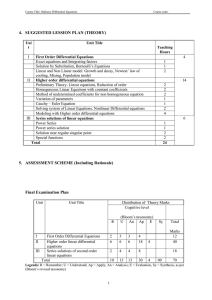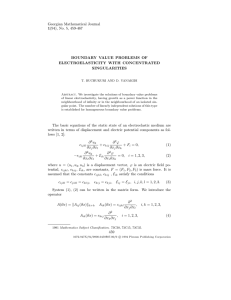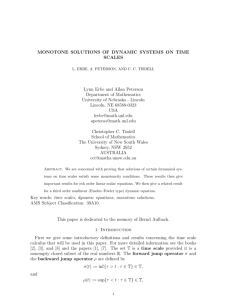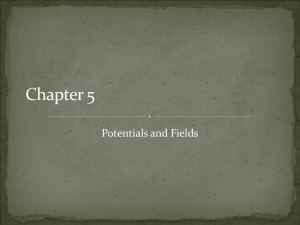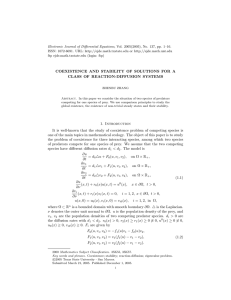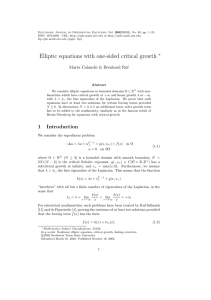BOUNDARY VALUE PROBLEMS FOR DIFFERENTIAL WITH REFLECTION OF THE ARGUMENT
advertisement
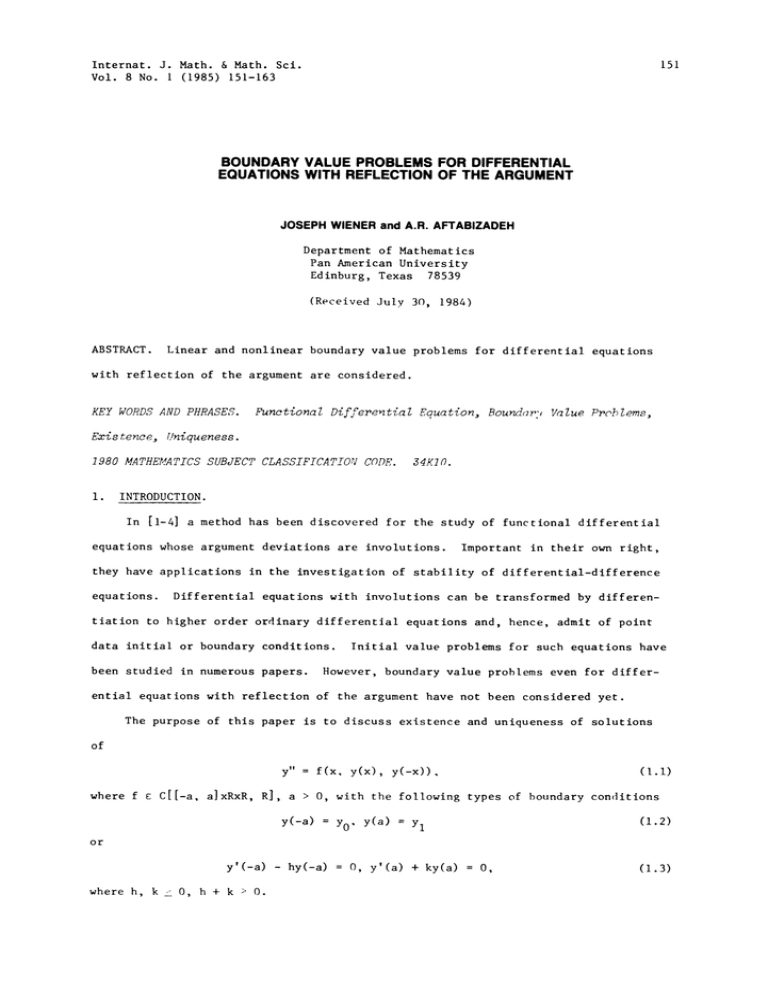
Internat. J. Math. & Math. Sci.
(1985) 151-163
151
Vol. 8 No.
BOUNDARY VALUE PROBLEMS FOR DIFFERENTIAL
REFLECTION OF THE ARGUMENT
EQUATIONS WITH
JOSEPH WIENER and A.R. AFTABIZADEH
Department of Mathematics
Pan American University
Edinburg, Texas 78539
(Received July
ABSTRACT.
30, 1984)
Linear and nonlinear boundary value problems for differential equations
with reflection of the argument are considered.
KEY WORDS AND PHRASES.
Functional
Differential Equation, Boundn. Value Problems,
Exis fence, Uniqueness.
1980 MATHEMATICS SUBJECT CLASSIFICATIOi CODE.
I.
34KI0.
INTRODUCTION.
In
[1-4]
a method has been discovered for the
study of functional differential
equations whose argument deviations are involutions.
Important in their own right,
they have applications in the investigation of stability of differential-difference
equations.
Differential equations with involutions can be transformed by differen-
tiation to higher order ordinary differential equations
data initial or boundary conditions.
been studied in numerous papers.
and, hence, admit of point
Initial value problems for such equations have
However, boundary value problems even for differ-
ential equations with reflection of the argument have not been considered yet.
The purpose of this paper is to discuss existence and uniqueness of solutions
of
y"
where f e
C[[-a, a]xRxR, R],
a >
f(x, y(x), y(-x)),
(I.I)
O, with the following types of boundary conditions
y(-a)
YO"
y(a)
(1.2)
Yl
or
y’(-a)
where h, k
O, h + k
O.
hy(-a)
0, y’(a) + ky(a)
0,
(1.3)
152
2.
J. WIENER AND A. R. AFTABIZADEH
PRELIMINARY RESULTS.
First, we prove a sequence of lemmas for the linear case,
a(x)y(x) + b(x)y(-x) + c(x),
y"(x)
which are needed in order to prove our results for the general equations of the form
(I.).
Before we proceed further, we present some results without proof, which help to
simplify the proofs of our results.
LEMMA 2.1.
[5, pp.182].
fl
If y(O)
i
2
y (x) dx <
0
LEMMA 2.2.
,
[6].
f(t, x, y)
If
[a, b]xP
with respect to x and y on
(t, x, y),(t,
)
1
C
I[0,
i],
then
2dx.
[y’ (x)
0
is continuous and has continuous first partials
where P is an open convex set, then for
[a, b]xP,
f(t,,)
f(t,x,y)
0 and y(x)
y(1)
s(t))(x- ) +
f2(t,r(t),
f3(t,(t),(t))(y-
y),
where
f2(t,r(t),s(t))
r), y +
x + (1
f2(t,
0
(I
and
fl
f3(t,(t),(t))
are continuous functions on
between x and x, and 0
LEMMA 2.3.
_<
Y
x + (I
f3(t,
[a, b]xP
), y +
))dT,
(I
s(t), (t) between y and
with
,
<_ I.
The homogeneous boundary value problem
0,
U
together with
u(a)
u(b)
O,
has the Green’s function G(x, t), defined by
[(b-x)(t-a),
a
<_
t < x < b
(b-t)(x-a),
a
<_
x
1
b-a
C(x, t)
<_
t
and the following estimates hold true:
[G(x
a
t)
[dt
<
(b-a)2
8
b
a
IGx(X
t)[dt
< b-a
2
Now consider the second order linear differential equation
_< b,
r(t), (t)
BOUNDARY VALUE PROBLEMS FOR DIFFERENTIAL EQUATIONS
y"
153
(2.1)
a(x)y + b(x)
with
where a(x), b(x) e
C[[a, b], R].
[F].
LEMMA 2.4.
O, h, k > O, h + k > 0,
0, y’(b) + ky(b)
hy(a)
y’(a)
Then
[a, b],
Suppose a(x) _> m > 0 on
then boundary value problem
(2.1) has a unique solution satisfying
< i
suply(x)
3.
suplb(x)
m
x e
[a b].
MAIN RESULTS.
We are now in a position to state our results.
LEMMA 3.1.
b
y2(x)dx
cl[a,
b],
then
[Y ’(x)]2dx"
a
I
This follows easily from Lemma 2.1.
LEMMA 3.2.
Since
fb
<-- [J
y(b)
y(a)
cl[a,
0 and y e
y(b)
If y(a)
suply(x)
PROOF.
--
Ib
(b_a)2
<
a
PROOF.
O, and y(x) e
y(b)
If y(a)
b],
then
[Y’(X)]2dx] I/2
a
<_ x <_ b.
a
0, then one has
x
iu
y’(t)dt
2y(x)
la
y’(t)dt,
x
or
21y(x)
<- I
lY’(t) Idt
lY’(t) Idt +
ly’(t)
a
x
a
or
sup lY(X)
ly’ (t)ldt,
<_
-
a < x
_<
b.
a
Using the Cauchy-Schwartz inequality we have
suply(x)
<1/2[
Thus
suply(x) <-LEMMA 3.3.
ib
dt
a
]i/ 2
ib
[y, (t)] 2d t
]1/2
a
<_x <_b
a
b
I [y’(x)]2dx]1/2
a<x<b.
a
Consider equation (2.1) with the boundary condition
y(a)
y(b)
O,
(3.1)
154
J. WIENER AND A. R. AFTABIZADEH
(a)2
>_- a 0 >
where a(x)
suply(x)
(b-a)2
<-2
y(x) of (2.1) and (3.1) satisfies
Then any solution
suplb(x) I,
[2-ao(b-a) 2]
a
<_
x
<_
(3.2)
b.
On multiplying (2.1) by y(x), and integrating the result from a to b, we
PROOF.
find, because of (3.1),
[y’(x)]2dx
b(x)y(x)dx,
a(x)y (x)dx
a
a
a
or
a
[y’(x)]2dx <_ a0
IY (x)
(x)dx + suplb(x)
dx"
a
a
Applying Lemma 3.1 and the Cauchy-Schwartz inequality, we get
[Y’(X)]2dx --<
a (b-a)
0
n
a
2
ib
2
[Y’(X)]2dx
(b-a)3/2
+
a
sup lbCx)l
I
1/2
b
[y’Cx)] 2 dx]
a
or
[y’ (x)
2
dx
]I /
n(b-a/2
2 <
2
a
-ao
(b-a)
2
suplbCx) I,
a<x<_b.
Lemma 3.2 and the above inequality then imply inequality (3.2),
Suppose a(x) and b(x) satisfy all conditions of Lemma 3.3.
LEMMA 3.4.
Then
problem (2.1) with the boundary conditions
y(a)
y(b)
YI’
(3.2)
Y2
has a unique solution.
PROOF.
First, we show the uniqueness.
(2.1), (3.2).
Let R(x)
u(x)
R"(x)
By Lemma 3.3, R(x)
unique solution.
Suppose u(x) and v(x) are solutions of
v(x), then
a(x)R(x),
O, which implies u(x)
R(a)
R(b)
v(x).
So problem (2.1), (3.2) has a
O.
To prove the existence, let u(x) and v(x) be solutions of the
following initial value problems
(i)
u"(x)
a(x)u(x) + b(x),
u(a)
YI’
u’(a)
0;
(ii)
v"(x)
a(x)v(x)
v(a)
O,
v’(a)
I.
We notice that u(x) and v(x) exist and are unique.
v(b)
v’(a)
O, then from v(a)
i.
Moreover, v(b)
O, (ii) and Lemma 3.3 we have v(x)
Therefore, by linearity,
y(x)
u(x) +
Y2-u(b)
v(b)
v(x)
O, because if
0 which contradicts
BOUNDARY VALUE PROBLEMS FOR DIFFERENTIAL EQUATIONS
defines the solution of the problem
(2.1), (3.2).
155
Proof is complete.
Let us now, consider the second order linear functional differential equation
C[-a, a],
where a(x), b(x), c(x)
tion on
[-a, a]
2.
<
O.
We shall show that, under certain condia boundary condition has a unique solu-
and obtain an estimate for such solution.
Ib(x)
Suppose that a(x) >-m,
LEMMA 3.5.
4a2(m+n)
a >
b(x), equation (3.3) with
tions on a(x) and
(3.3)
a(x)y(x) + b(x)y(-x) + c(x)
y"(x)
< n, b(x) # O, x e
[-a, a], and
Then any solution of equation (3.3) with the boundary conditions
y(a)
y(-a)
(3.4)
O,
satisfies
suply(x)
2a
2
<
2_4a
2
suplc(x)
(3.5)
-a < x < a.
(m+n)
On multiplying (3.3) by y(x) and integrating the result from -a to a we
PROOF.
have
[y’(x)]2dx
a(x)
-a
(x)dx
b(x)y(x)y(-x)dx
-a
a
c(x)y(x)dx,
a
or
[y’ (x) ]2dx <
lY(X) lY(-X) Idx + suplc(x)l
(x)dx + n
m
a
-a
-a
ly(x)
-a
Now, using Lemma 3.1, the Cauchy-Schwartz inequality, and the facts that
< 1
[y 2 (x)
ly(x) IIy(-x)l
+
y2 (-x)],
and
2
y (x)dx
-a
I_
a
y2(-x)dx,
a
we obtain
a
[|
[y’(x)]2dx] I/2 _<
J_ a
n(2a)3/2
2-4a2(m+n)
sup[c(x) I,
-a
<_ x<a.
(3.6)
Applying Lemma (3.2) and inequality (3.6) we get inequality (3.5).
Having Lemma 3.5, we can prove the following theorem.
THEOREM 3.1.
In addition to the assumptions of Lemma 3.5, suppose that a(x) and
b(x) are even functions on
[-a, a].
y(-a)
has a unique solution.
Then equation (3.3) with the boundary conditions
YI’
y(a)
Y2
(3.7)
J. WIENER AND A. R. AFTABIZADEH
156
PROOF.
Uniqueness follows from the fact that if u(x) and v(x) are two solutions
of (3.3), (3.7), then R(x)
v(x) implies
u(x)
R"(x)
a(x)R(x) + b(x)R(-x),
R-a)
R(a)
Hence, from Lemma 3.5, R(x)
0.
v(x).
0 and u(x)
Now, we show that problem (3.3), (3.7) in fact has a solution.
(3.8)
y(-x).
y(x)
u(x)
Let
Then
(3.9)
y"(-x).
y"(x)
u"(x)
From (3.3) and (3.9) we have
a(x)y(x) + b(x)y(-x)
u"(x)
Since a(x) and b(x) are
c(-x).
even, then
a(x)[y(x)
u"(x)
a(-x)y(-x)-b(-x)y(x) + c(x)
y(-x)]
b(x)[y(x)
y(-x)] + c(x)
c(-x),
or by (3.8),
u"(x)
[a(x)
u(-a)
Yl
b(x)]u(x) + c(x)
c(-x),
(3.10)
and
Problem
(3.10), (3.11)
solution u(x).
Y2’
u(a)
is a form of
Y2
(3.11)
Yl
(2.1), (3.2), then by Lemma 3.4,
it has a unique
Hence y(-x) is given by
y(-x)
y(x)
u(x).
This implies that
y"(x)
[a(x) + b(x)]y(x) + c(x)
y(-a)
YI’
b(x)u(x)
(3.12)
and
Again by Lemma 3.4, Problem
tion of
(3.3), (3.7).
y(a)
(3.13)
Y2"
(3.12), (3.13)
has a unique solution which is the solu-
Proof is complete.
Now consider the following second order linear functional differential equation
y"(x)
where a(x) # 0 on
[-a, a].
a(x)y(-x) + b(x)
(3.14)
By differentiation and algebraic elimination this equa-
tion can be reduced to the fourth order differential equation
y
where
(4)
(x)
A(x)y"’(x) + B(x)y"(x) + C(x)y(x) + D(x), x
6
I-a, a],
(3.15)
BOUNDARY VALUE PROBLEMS FOR DIFFERENTIAL EQUATIONS
A(x)
2a’ (x)
a(x)
B(x)
(x)l
ra’
---,
C(x)
a(x)a(-x),
a’(x) 2
a(x)
O(x) -a(x)[b(-x) +
l
"
1
a ’(x)
%-
157
a2_x_
()
,
rb(x)
La-
By a solution of (3.14) we mean a solution that is four times dlfferentiable.
We shall show that equation (3.15) with the boundary conditions
AI,
y(-a)
y(a)
A2,
y"(-a)
Sl,
y"(a)
B
(3.16)
2
We use the method given by R. A. Usmanl [8].
has a unique solution.
First we need
the following Lemma.
LEMMA 3.6.
Consider the fourth order linear differential equation (3.15) with
the boundary condltion
y(.-a)
where A(x) e
cl[-a,
Ic(x)l
If
_< n.
y"(-a)
y(a)
y"(a)
O,
(3.17)
a], B(x), C(x), D(x) e C[-a, a],
+ 16na 4 <
4m2a 2
then any solution of
1
A’(x)
l(x) <_m and
4
(3.18)
(3.15), (3.17) satisfies
4
suply(x) <PROOF.
4
-4m2a2-16na 4
suplD(x) l,
-a
<_x_<
a.
(3.19)
Let
yl!
(3.20)
Z.
On multiplying (3,20) by y(x) and integrating the result from -a to a, we have
[y (x)
2dx
yzdx,
a
or
_a
[y’(x)]2dx <[
a
i_a y2(x)dx ]I/2 i_a
a
2
z (x)dx
]1/2
a
Applying Lemma 3.1, we obtain
[y,(x)]Zdx
a
Also, from (3,20) and (3.15)
2
_<
n2
[z,(x)]2dx
a
2
(3.21)
J. WIENER AND A. R. AFTABIZADEH
158
z"
A(x)z’ + B(x)z + C(x)y + D(x),
z(a)
z(-a)
(3.22)
O.
In a similar manner,
3
[z’ (x) ]2dx
suplD(x)
4_
2-16ha
4_4ma
a
a
<_
x <_ a.
(3.23)
From Lemma 3.2, (3.21) and (3.23) inequality (3.19) follows.
THEOREM 3.2.
(3.15), (3.16)
has a unique solution.
(3.15) and (3.16).
(4)
Then it is easily seen that (x)
A(x)"’ (x)+B(x)"(x)+C(x)(x), (-a)
(x)
Now, from Lemma 3.6 and (3.24)
and u(x)
Then problem
Assume that there exist two distinct functions u(x) and v(x) satisfying
PROOF.
4
Suppose all assumptions of Lemma 3.6 hold true.
v(x) on
[-a, a].
it follows that
u(x) -v(x) satisfies
(a)
"(-a)
supl(x) <_ O,
This shows that problem
"(a)
which proves
(3.15), (3.16) has
O. (3.24)
(x)
0
at most one
solution.
In order to prove that (3.15), (3.16) indeed has a solution, we define functions
Yi(X),
4, as solutions of the respective initial value problems:
i,
i
(1)
yI(4) A(x) Y’ +B (x) Y’+C(x) Yl+D(x)
(ii)
y
(ill)
y4) =A(x)y’ +B (x) y+C (x) y3,
(iv)
Y4
=A(x)
(4)
+B (x)
Y2
Yl (-a) =AI
YI’ (-a) yl (-a)Y[
(-a) 0
Y2’(-a)=l’
y2(-a)-Y2"(-a)fy
(-a)=0;
Y(-a) B 1 Y3(-a)ffiy (-a)y’ (-a) O
A(x)"’+B(x)y2+C(x)y
Y4
4
-Y4"’ (-a)
1
Y4 (-a)Y (-a)--y4’’ (-a) 0
From the continuity of A(x), B(x), C(x), and D(x) we are assured that unique solutions of these initial value problems exist on
z(x)
[-a, a]. Furthermore,
+ sy 2(x) +
Yl(X)
Y3(X)
the function
+ ty 4(x),
s, t being scalars, satisfies the initial value problem
z(4)=A(x)z"’+B(x)z"+C(x)z+D(x),
z(-a)
The function z(x) will be a solution of
sY2(a)
If A
Y2(a)Y"4(a)
Y2(a)Y4(a)
+
tY4(a)
# O,
AI,
z’(-a)
s, z"(-a)
(3.15), (3.16) provided s,
A2
Yl(a)
BI,
z"’(-a)
t satisfy
Y3(a),
a unique solution of the preceding linear
t.
159
BOUNDARY VALUE PROBLEMS FOR DIFFERENTIAL EQUATIONS
system can be found, and the corresponding function z(x) then is the unique solution
of
However, if A
(3.15), (3.16).
O, then
Y2(a)
Y4(a)
y(a)
y(a)
p (constant).
We can assume that p # O, because if p
Y2(a)
O, then
0 and by means of
Taylor’s
formula it can be shown that the solution of
(4)
Y2
A(x)-"’+ B(x)
Y2
Y2’(-a)
has the property
+ C(x)y 2
Y2
Y2(a)
Y2"(-a)
Y2
(-a)
y2(-a)
0, contradicting the original assumption
Similarly, p cannot be unbounded.
Y2(a)
0
y(-a)
i.
Thus it follows that
py(a),
p < oo.
(3.25)
Now using (ii), and the Taylor formula, we obtain
Y2(a)
2a
+
2
a
4
[A(a)
y ’(a)
+ B()
y () + C()y2(a)]
a < a < a,
(3.26)
2a2[A(8)y
y(a)
(8) +
C(8)y2(8)]
+
B(B)y2(8)
a <
8 < a.
On combining (3.25) and (3.26) we get
i
ap[A(8)y (8)+B(8)y2(8)+C(8)y2(8)]
C[-a, a].
for all A(x), B(x), C(x)
Y2"(8)’ Y2"’ (a)
and
y’(8),
a
3
[A()
y, ()+B()y 2 (a) +C (a) y2 (a) ]=i,
In an attempt to determine
y2(a), y2(), y2(a),
we choose
A(x)
I, B(x)
i, C(x)
A(x)
i, B(x)
I, C(x) =-I,
i,
A(x) =-I, B(x) =-I, C(x)
I,
A(x) =-I, B(x) =-i, C(x) =-i,
A(X)
I, B(x) =-I, C(x)
A(x)
i, B(x) =-i, C(x) =-i,
I,
giving the system
ap[Y2 (B) + Y2"(8) +
ap[y
2
(8) +
y(8)
ap[-y’ ()
y2(),,
ap[y 2 (8)
y2(8)]
Y2"(8)
ap[-y 2 (8)
y(8)
y2(8)]
+
y2(8)]
Y2(8)]
+
y2(8)]
I
i
a
a
3
3
[Y2
() +
......
+ Y2
[Y2
()
I a3f[_y2,,,
-i
I
a
a
Y2"()
3[
3
(e)
y, ()
[Y2
()
()
+
y2(e)]
1
Y2 (a)]
I,
Y () + Y2(a)]
Y () Y2(a)]
y () + Y2 ()]
i,
I
i
-
J. WIENER AND A. R. AFTABIZADEH
160
ap[y
i
y () y2(8)]
()
2
But this latter system in the unknowns
a
3
[Y2’ (a) Y2 (a)
y2(a), y2(8),
Y2 (a)
I
We thus
is inconsistent.
conclude that A cannot vanish and the proof of the theorem is completed.
Now,
problem (3.14) with y(-a)
it is easy to show that
y(a)
0 has a unique
solution.
THEOREM 3.3.
C[-a a], b(-a)
Suppose a(x)
g
la(x)a(-x) _<
n.
Consider equation (3.14).
b(a)
2
[a’(x)
<- m
a(x)
O,
and
C
(2)[-a,
a] b(x)
If
4m’n’2a 2
+
16ha
4
<
l
4
then equation (3.14) with
y(-a)
y(a)
(3.27)
O,
has a unique solution.
PROOF.
Since equation
(3.14) can be reduced to equation (3.15), then by theorem
3.2, problem (3.14), (3.27) has a unique solution.
Now, we consider the general equation (i.I) and prove the following theorems.
THEOREM 3.4.
Suppose f is bounded on [-a, a] xRxR.
Then problem (I.i), (1.2)
has a solution.
PROOF.
Problem
(I.I), (1.2)
=-
+
y(x)
where
G(x,t)
(yl+Yo)
(yl-Yo)X
is given by Lemma 2.3.
Define a mapping T:E
+
(3.28)
C(x,t)f(t,y(t), y(-t))dt,
Let M be the bound of
Ifl
on
[-a, a]
xRxR.
E by
I
+
(yl+Yo
Ty(x)
where E
is equivalent to
C[[-a, a], R]
lYl
i
+
a(Yl-Yo)X
I_
a
G(x,t)f(t,y(t), y(-t))dt,
(3.29)
a
is a Banach space with the norm
E
max
ly(x)I,
Then from (3.29) and the estimates on
lTy(x)[ i
1
a < x < a.
G(x,t) and Gx (x,t),
lyl+Y01
+a1 IYl-Y01
it follows that
+7 azM’
1
(3.30)
and
IT’y(x) I-<
a IYl-Y01
+ aM.
Hence, T maps the closed, bounded, and convex
B
{y e E: ly(x) _<
i
(3.31)
set
lyl+Yol + a1
IYl-Yol
+
1
2
a M
161
BOUNDARY VALUE PROBLEMS FOR DIFFERENTIAL EQUATIONS
into itself.
Moreover, since T’y(x) verifies (3.31), T is completely continuous on
C[[-a, a], R]
by Ascoli’s theorem.
(I.i), (1.2), thus completing the proof of
is a solution of
T, which
a fixed point of
The Schauder’s fixed point theorem then yields
the theorem.
THEOREM 3.5.
[-a, a] xRxR,
Suppose f is continuous and for (x,y,z), (x,y,z)
it satisfies a Lipschitz condition
f(x,,)I
If(x,y,z)
where L
I
and L
2
> O.
el IY-l
<
Iz-l,
+ e2
(3.32)
(i.i), (1.2) has a unique solu-
Then the boundary value problem
tion, provided
2
a (L
PROOF.
(3.33)
< 2.
L
I + 2)
C[[-a, a], R]
Let B be the Banach space of functions y
[IY[
max[y(x)I,
B
B by (3.29),
Define the operator T:B
ITYI(X) TyZ(x)
<
a
-a < x
Then for
with the norm
<_ a.
Yl(X)
and
Y2(X)
g
B, we have
IC(x’t) [If(t’Yl(t)’ Yl(-t))-f(t’Y2 (t) ,y2(-t)
Using the Lipschitz condition (3.32) we obtain
a
ITYl(X) TY2(X)
IG(x,t) l[LiIYl(t)-Y2(t) +
<
L21Yl(-t)-Y2(-t) l]dt,
or
ITYI(X)
TY2(X)
<
a2 (LI+L 2
2
maxlYl(X) Y2 (x) I,
a < x < a,
or
[Iry l(x)
Ty
2(x)[] B _<
a2(LI+L2
2
[[yI(x)
y2(x)
Also,
IT’Yl(X) T’Y2(X) ll B < a(Ll+L2) lly l(x)
All of these considerations and inequality (3.33) show that T is a contraction
mapping and thus has a unique fixed point which is the solution of
(i.i), (1.2).
Proof is complete.
THEOREM 3.6.
(i)
Assume that there exist positive numbers m and r such that
sup f(x,0,y)
<_
2_4ma2
2a
(ii)
f(x,y,z) has
[-a, a]xRxR
2
r, for x
E
[-a, a], lyl <_
,
a continuous partial derivative with respect to y on
and
J. WIENER AND A. R. AFTABIZADEH
162
2
f2(x,y,z)
>
m >
-____n
4a
[-a a], y
for x g
2
g
Izl
R,
< r
Then equation (i.i) with the boundary conditions
y(a)
y(-a)
(3.34)
0,
has a solution.
PROOF.
a mapping
Let B
r
C[-a, a]:ly _< r}.
{y
C[-a, a]
T:C[-a, a]
by (Ty)(x)
B
For y
r
and x
[-a, a],
define
v(x), where
v"(x)
f(x,v(x),y(-x)),
(3.35)
v(-a)
v(a)
(3.36)
and
O.
Equation (3.35) is equivalent to
f(x,v(x),y(-x))- f(x,O,y(-x)) + f(x,O,y(-x)).
v"(x)
Then from Lemma 2.2, it follows that
v"(x)
0
f2[x,Tv(x),y(-x)ld’r)v(x)
(3.37)
+ f(x,O,y(-x)).
Applying Lemma 3.3 and condition (ii) we have
sup ]vCx)
<-
or from (i)
2a
2
n2_4ma 2
suplf(x,O,y(-x))I,
sup lv(x)
<__ r,
x_<
a <
Hence, T maps the closed, bounded, and convex
set B
a <_ x < a,
(3.38)
a.
r
into itself.
Moreover, from
(3.35), (3.36) and Lemma 2.3
a
v(x)
G(x,t)f(t,v(t),y(-t))dt,
a
or
a
v’(x)
-a
Since
If(x,v(x),y(-x)) <_
Gx(X,t)f(t,v(t),y(-t))dt.
k, for x e [-a,
Iv’(x) <--
a], Iv(x) _< r, ly(-x) <_
(3.39)
r, then
de.
All of these considerations show that T is completely continuous by Ascoli’s theorem.
Schauder’s fixed point theorem then yields a fixed point of T, which is a solution
of
(I.i), (3.34).
EEOR 3.7.
Assume that there exist positive numbers m and r such that
(i)
suplf(x,0,y) <_
(ii)
f(x,y,z) has
mr, for x e
[-a, a], [Yl <_
a continuous partial
r,
derivative with respect to y on
[-a, a]xRxR
and
BOUNDARY VALUE PROBLEMS FOR DIFFERENTIAL EQUATIONS
_>
f2(x,y,z)
m > 0, for x e
[-a, a],
Izl
y e R,
163
<_ r.
Then the boundary value problem (i.i), (1.3) has a solution.
PROOF.
T:C[-a,
Let B
{y
r
C[-a, a]
C[-a, a]:
E
by (Ty)(x)
v"
IYl <-- r}.
For y E B
r
define a mapping
v(x), where
f(x,v(x),y(-x))
v’(-a)
(3.40)
0, v’(a) + kv(a)
hv(-a)
(3.41)
0.
Equation (3.40) is equivalent to
v"
0
f2[x,Tv(x),y(-x)]dT)v(x)
+ f(x,0,y(-x)).
Using Lemma 3.3 and conditions (i), (ii) we obtain
sup lv(x)
This shows that T maps B
r
into itself.
v’(x)
Since v’(-a)
x
[-a, a],
hv(-a), then
Yl --<
r,
zl
<__ r,
a
<_ x <
a.
Also from (3,40) we have
v’(-a) +
I_
x
f[t,v(t),y(-t)]dt.
a
Iv’(-a) _< hlv(-a)
< hr.
Moreover,
If(x,y,z) <_
k for
< r, then
Iv’(x) _<
hr
+ 2ak.
Thus, T is completely continuous by Ascoli’s theorem.
Schauder’s fixed point theorem
then yields a fixed point of T, which is a solution of (1.1), (1.3).
ACKNOWLEDGEMENT.
Research partially supported by U.S. Army Grant #DAAG29-84-C-O034.
REFERENCES
PRZEWORSKA-ROLEWICZ, D. Equations with Transformed Argument, An Algebraic
Approach, Panstwowe Wydawnictvo Naukowe, Warszawa, (1973).
2.
WIENER, J. Differential equations with involutions, Differencial’nye Uravnenija
6, (1969), 1131-1137.
3.
WIENER, J. Differential equations with periodic transformations of the argument.
(1973), 481-489.
Izv. Vyss. Ucebn. Zaved. Radiofizika,
4.
WIENER, J. Periodic maps in the study of functional differential equations,
Differentcial’nye Uravnenia(Iryazan), 3, (1974), 34-45.
5.
HARDY, G.H., LITTLEWOOD, J.E., and POLYA, G.
Press, London and New York, 1952.
6.
BEBERNES, J.W. and GAINES, R. Dependence on boundary data and a generalized
(1968), 359-368.
boundary-value problem, J. Differential Equations,
7.
CORDUNEANU, C.
8.
USMANI, R.A.
,
Ine.qualities, Cambridge Univ.
,
Sopra I problemi ai limiti per alcuni sistemi di equazioni
differenziali non lineari, Rendiconto Academia Napoli, (1958), 98-106.
A uniqueness theorem for a boundary value problem, Proc. Am. Math.
Society, vol. 77, no. 3, Dec. (1979), 329-335.
